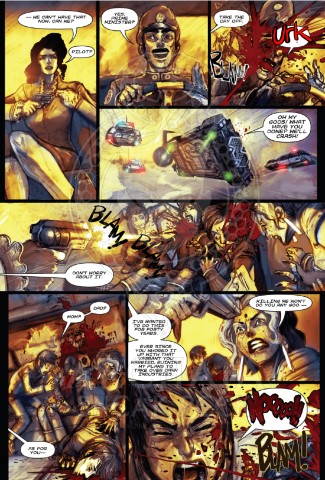Archaia Comics Critical Millennium, now up
to the second issue in this limited series, is a comic that Stephen
Hawking would definitely approve of. Why exactly would the great man
approve, well I’ll break it down for you.
Stephen Hawking recently claimed that, due to
human nature, we are basically going to destroy the Earth. While
we’ve been at peace for sometime he can see man destroying the Earth
through war or some man caused environmental disaster in the near
futue (read: a couple of life times). With that in mind he is urging
people to consider space travel and galactic colonization as a way
of safe guarding the human race. If we destroy Earth then hey, at
least we’ll still have Mars is the basic idea.
As if reading Stephen Hawking’s mind Critical
Millennium deals with such an issue. The comic, set in the
future, sees humanity managing to colonise many of the planets
within our own solar system. Unfortunately, these colonies rely
heavily on trade with Earth as it produces resources these planets
cannot. There are those, in the private sector, who see the future
of the human race in the expansion towards other galaxies where an
Earth-like planet can be found. While the private sector is all for
this expansion the Earth government and shadowy terrorist groups are
not so keen on the idea and are blind to the plight of the Earth.
This sets up a tense atmosphere where the fate of mankind is
literally at stake.

The second issue sees the possibility of
inter-galactic space travel emerge as an ever closer possibility.
The technology to perform such a feat is ready, with only live
testing required. This revolutionary technology requires the
creation of a black hole to reach the required destination. With
their goal so close the two highly influential and wealthy investors
in the project are beginning to have concerns over opening a black
hole and what the outcome would be if it could not close. Meanwhile
on Earth terrible environmental disasters plague the country with
the most recent one affecting the Ghost quarter in New Bombay, an
area filled with slums, the poor and street gangs. Those few who
survive view the disaster as a deliberate act caused by the private
sector and the Ghosts, a terrorist group of the now minority white
population, begin to plot their revenge and justice. Meanwhile there
is intense uncertainty as to what the first expedition outside our
galaxy will find on the planets of neighbouring galaxies, further
adding to the tension.
Critical Millennium
#2 manages to weave several interesting plots and political issues
together in the one book. Theirs the Ghosts and the problems that
face Earth, the space travel experiments which are getting closer
and closer to the real deal and the personal problems of Thomm
Coney. The thing with Critical Millennium is the story
doesn’t feel crowded. Everything flows logically and the competing
plot lines and the political messages manage to get just enough
attention to satisfy your curiosity yet leave you pining for more.
There was one part with Thomm that I didn’t quite understand and
felt the book should have returned to or at least commented o n more
but for the most part it was handled well. I did like the way it
started with a bang, literally, as it was a pretty confronting way
to start the issue. Unfortunately, I found Wraith and the Ghosts
dialogue at the end fairly boring, stereotypical revolutionary and
hopefully their actions work better than their words. Also, if life
on Earth is so bad for them now they are the minority wouldn’t they
like to leave? The corrupt and diabolical Prime Minister seems to
want everyone to stay and seeing as they are opposed to her wouldn’t
they doubly want to leave? Their motives seem confused, like they
don’t know who the real ‘enemy’ is.
The artwork throughout Critical Millennium
is, for the most part, fantastic. There are a couple of pages that
are stunningly beautiful, like the shot of the space ship zipping
around the Sun and the scenes in New Bombay’s Ghost Quarter. The way
they blend colors is amazing and especially in the Ghost panels you
get the sense that it’s a dirty, downtrodden place. Unfortunately
the expressions on the characters often didn’t do it for me. There
were times when they seemed over animated and unnatural while the
use of action words during the environmental disaster was a little
excessive, almost taking over the panel and directing attention away
from the brilliant artwork, which had you hoping someone, would
survive. Finally the black hole panel, which was a pivotal moment,
was done in a style I’ve seen before but am not a fan of. The black
outlines of the panels looked rushed and unfinished and out of place
compared to the rest of the art style. It gave an impression of
laziness in comparison to the rest of the issue.
Overall Critical Millennium #2 was a
thoroughly enjoyable read with an engaging and soon to be relevant
storyline and at times brilliant artwork. Even with a few setbacks
I’m eagerly anticipating the next issue.